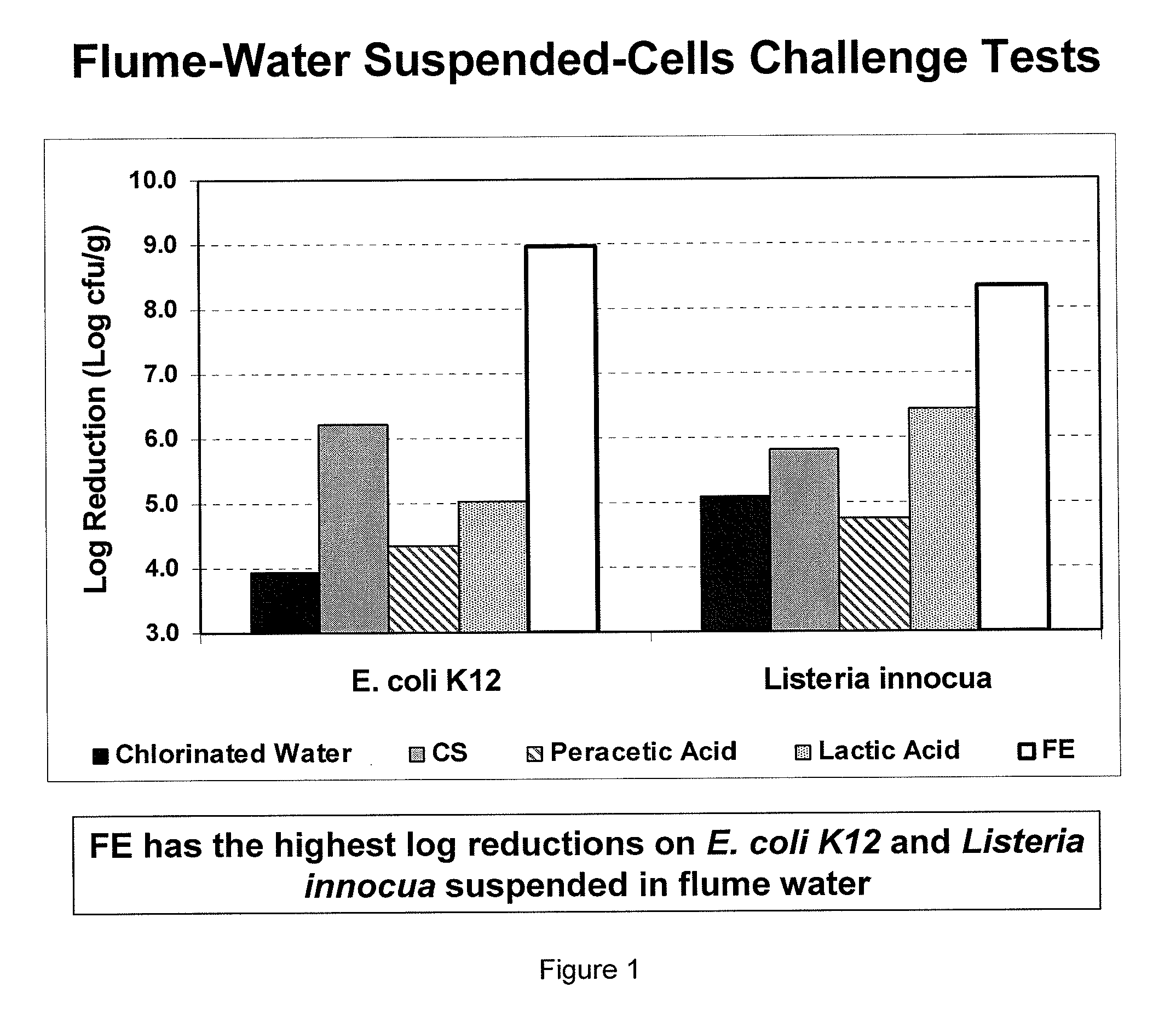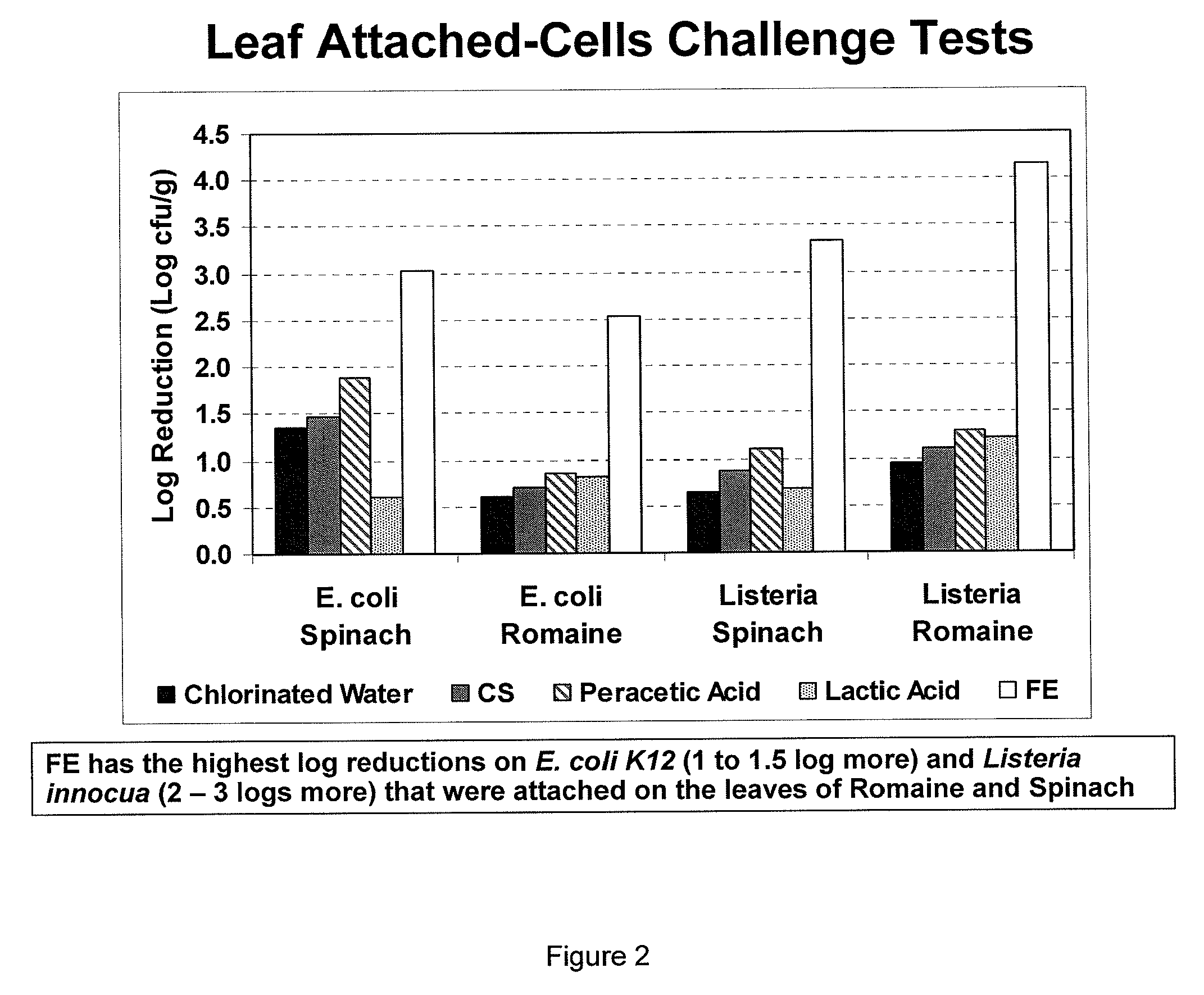Peracid and 2-hydroxy organic acid compositions and methods for treating produce
a technology of organic acid compositions and organic acids, applied in the field of peracid and 2hydroxy organic acid compositions and methods for treating produce, can solve the problems of spoilage of produce, inadequate control of microorganisms in existing methods for removing or reducing microorganisms from food, etc., and achieve the effects of preventing spoilage of produce, preserving the quality of produce, and sanitizing the surface of produ
- Summary
- Abstract
- Description
- Claims
- Application Information
AI Technical Summary
Benefits of technology
Problems solved by technology
Method used
Image
Examples
example 1
[0073]The present example illustrates the use of an aqueous sanitizing solution according to the invention. As illustrated in FIGS. 1 to 16, the solutions according to the invention advantageously remove microorganisms from the surface of a variety of produce, inhibit the growth of indigenous microorganisms on the treated produce, and can remove model pathogens from the surface of the produce. The methods and compositions of the invention are also shown to greatly improve the shelf-life of the produce and greatly retard produce decay. The findings extend to such diverse microorganisms as bacteria, yeast, and mold.
A. Standard Operating Procedure for Shelf Life Study
[0074]This method can be used to determine the shelf life of produce that has been treated by a sanitizing solutions, generally and, particularly, those according to the invention.
Preparation
[0075]Cooled eight 20-gallon containers with 75% water to ˜45° F.[0076]Autoclave twelve 5-gallons tubs wrapped well in tin foil at le...
example 2
[0160]The next example demonstrates that the presence of a 2-hydroxy organic acid (e.g., lactic acid) greatly reduces the consumption of peroxyacetic acid during the treatment of produce and illustrates the use of an aqueous sanitizing solution according to the invention. As shown below, the solutions according to the invention advantageously conserve peroxyacetic acid during the removal of microorganisms from the surface of a variety of produce. The methods and compositions of the invention are also shown to greatly improve the shelf-life of the produce and greatly retard produce decay. The savings should extend to such diverse microorganisms as bacteria, yeast, and mold.
Synergism with Respect to Efficacy in a Suspended Cells Challenge Test at 20 s Residence Time with No Surfactant.
[0161]The experimental treatment groups were tap water, chlorinated water, a FE sanitizer wash water (FE, FE sanitizer, a solution of peroxyacetic acid and lactic acid, as further specified in a given ex...
example 3
[0183]The next experiments compares the effects of sanitizers on vegetative pathogens suspended in a liquid.
Processing Parameters and Treatments
[0184]Treatments: tap water, chlorinated water, FE sanitizer wash water;[0185]Temperature: 40 to 45° F.; Residence time: 30 s pH:[0186]water (˜7)[0187]chlorinated water (6.5 to 7.1)[0188]FE sanitizer wash water (2.7 to 3.2)[0189]Pathogens:[0190]5-strains cocktail of E. coli 0157:H7 (F4546, F4637, SEA13B88, TW14359, 960218)[0191]5-strains cocktail of Listeria monocytogenes (ATCC 19115, ATCC51414, ATCC15313, FRR B2472 (SCOTT A), 1838)[0192]5-strains cocktail of Salmonella (S. Newport, S. Tennessee, S. muenchen, S cubana, S. St. Paul)
Activation of Stock Culture
[0193]1. Activation of stock culture is attained via a series of transfers of stock culture to optimum growth medium aseptically in a biological safety cabinet[0194]2. Retrieve a small loop (˜100 uL) of pure culture from the stock culture in storage and transfer it into a test tube contai...
PUM
 Login to View More
Login to View More Abstract
Description
Claims
Application Information
 Login to View More
Login to View More - R&D
- Intellectual Property
- Life Sciences
- Materials
- Tech Scout
- Unparalleled Data Quality
- Higher Quality Content
- 60% Fewer Hallucinations
Browse by: Latest US Patents, China's latest patents, Technical Efficacy Thesaurus, Application Domain, Technology Topic, Popular Technical Reports.
© 2025 PatSnap. All rights reserved.Legal|Privacy policy|Modern Slavery Act Transparency Statement|Sitemap|About US| Contact US: help@patsnap.com



